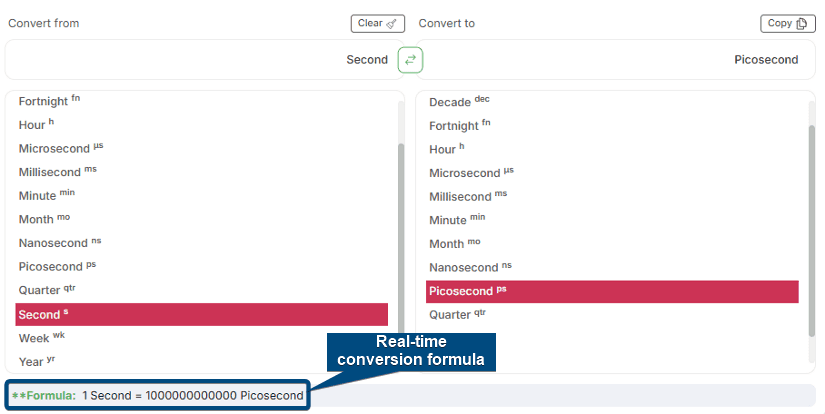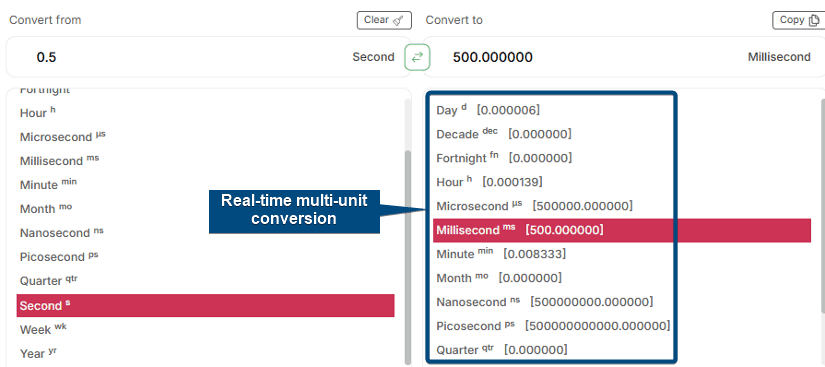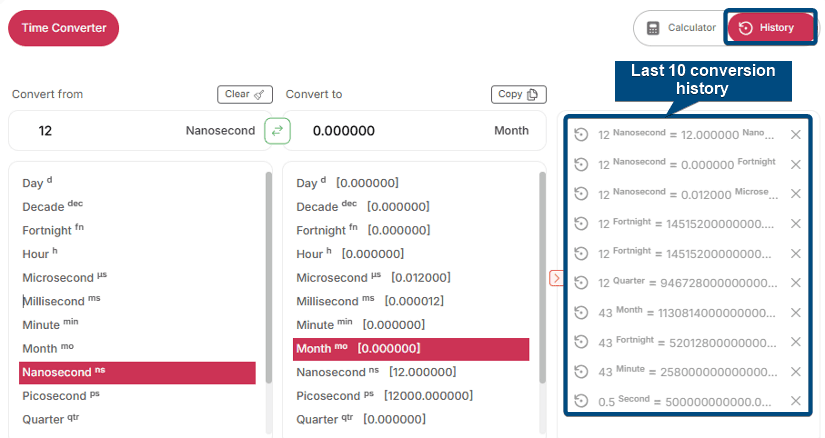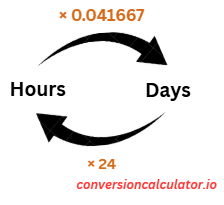HomeTime Converter
Time Conversion Calculator
From nanoseconds to centuries, convert time in all its forms.Time Converter
Convert from
Convert to
**Formula:
Discover Other Unit Converters
Updated on September 1, 2025
Our Time Conversion Calculator is a fast, easy-to-use online tool that helps you convert between 14 time units including seconds, minutes, hours, days, weeks, months, years and more in just a few clicks. It offers real-time multi-unit conversion for instant results, a built-in scientific calculator for complex time-related calculations, customizable decimal precision for accurate outputs, flexible number formats for better readability, and automatic conversion history for quick access and reuse. In this article, I'll explain how the converter works, detail all supported units and highlight the features that make time conversion quick and hassle-free.About Time Conversion Calculator
Written By Nadiba Rahman
Nadiba Rahman
Reviewed by Mrinmoy Roy
Mrinmoy Roy
Share This Post
URL copied!
What is Time?
Time is a measurement that shows how long something takes and when it happens. It helps us understand the order of events in the past, present, and future. Time is measured in different units based on how short or long something is, such as seconds, minutes, hours, days, and years.Tools like calendars, clocks, and watches are used to keep track of time. Calendars count years, months, and days. And clocks and watches show the time in hours, minutes, and seconds.
Conversion Units Available in Our Time Converter
Here’s a quick overview of the time units available in our time conversion calculator:- Day: Used for daily routines, work hours, and tracking events that happen over a 24-hour period.
- Decade: Used to measure long-term time spans such as historical periods, economic trends, or generational changes.
- Fortnight: A two-week span, popular in payroll, scheduling, and planning, especially in regions like the UK and Australia.
- Hour: A widely recognized unit for managing work schedules, travel times, and appointments, event planning.
- Microsecond: Essential for tasks requiring extreme precision, such as in computing, engineering, and data transfer.
- Millisecond: Crucial in computing, gaming, and any system where reactions and responses need to be nearly instant.
- Minute: The standard for measuring time in most daily activities, such as appointments and short meetings.
- Month: Useful for budgeting, scheduling, financial reporting, and measuring durations over a month-long period.
- Nanosecond: Crucial in computer science, telecommunications, and scientific research for ultra-fast processes.
- Picosecond: A trillionth of a second; used in scientific fields like physics and chemistry for extremely short time intervals.
- Quarter: Divides the year into four parts; commonly used in financial reports, academic calendars, and business planning.
- Second: The basic unit of time used universally across science, technology, and daily timekeeping.
- Week: Ideal for scheduling tasks, work plans, and weekly routines.
- Year: The longest unit commonly used for tracking personal milestones, age, seasons, and historical events.
How to Use Our Time Conversion Calculator?
Using our time conversion calculator is quick and simple. Just follow these steps:Select the Source and Target Units
Choose the time unit you want to convert from and to.
Enter the Time Value
Type the time value you want to convert.
Get Instant Output
The converted result appears instantly in the target unit. You can copy the result easily with just one click.
Features of Our Time Conversion Calculator
Our time conversion calculator offers various useful features that make converting time easy and accurate. All features are accessible through the settings menu, so you can customize the tool to match your specific needs.Real-Time Multi-Unit Conversion
Imagine you're working with a sensor that sends data every 0.5 seconds. To set it up correctly, you need to know how many milliseconds, microseconds, or nanoseconds that is. Our converter solves this by instantly showing the equivalent values in all supported time units at once, in real time. You don’t have to do any manual conversions.
Adjustable Decimal Precision
Suppose you're measuring a time delay of 1.234567 seconds in a system. To analyze it properly, you need to convert it to milliseconds with high precision. If the result isn't accurate enough, it can affect the whole calculation. That's why decimal precision matters in time conversions, especially when you're working with tiny units like milliseconds, microseconds, or nanoseconds.Our time converter lets you control how precise the result should be. You can set the number of decimal places from 0 up to 12. By default, it shows 6 decimal places, but you can adjust this based on your task.
Rounding Mode Control
When working with time, even a small rounding difference can change the outcome, especially in scheduling or precise measurements. If a time value is rounded the wrong way, it might cause delays, bugs, or calculation errors. That’s why rounding needs to be handled carefully based on what your task requires.Our time converter gives you full control over rounding. You can choose to round up, round down, or turn off rounding completely. By default, rounding is off, so you get the full value. But if your project needs clean, rounded numbers, you can easily switch it on and pick the option you want.
Flexible Number Formats
Time values can be very large or extremely small. When numbers get too big or too tiny, they can be hard to read or understand. This can slow you down or cause mistakes, especially when working with units like picoseconds or hours.To make things easier, our time converter lets you choose how to display numbers. You can pick from three different number format:
- Standard Decimal (like 12.3456)
- Scientific Notation (like 1.23456e+1)
- Engineering Format (like 12.3456 × 10^0)
Integrated Scientific Calculator
When working with time, you often need to do quick math, like breaking down seconds into hours or adding milliseconds and microseconds. If you switch between different apps to do these calculations, it can slow you down and lead to mistakes.That’s why our tool has a built-in scientific calculator. You can do all your time-related calculations right here and then send the result straight to the converter. It saves you time, keeps everything in one place, and helps you avoid errors.
Thousand Separator Toggle
Suppose you’re working with large time values like microseconds or nanoseconds. These big numbers can be hard to read without proper spacing. It’s easy to miss a digit or make mistakes while reading without commas or separators.Our time converter lets you turn the thousand separator on or off. When it’s on, numbers like 1000000 appear as 1,000,000, that makes them easier to read and check.
Quick Unit Swap Option
Let’s say you're converting hours to minutes. Now you need to convert it in reverse, like minutes to hours. But if you do this manually, it will take a lot of time and increase the chance of mistakes.That’s why our time converter includes a one-click swap button. When you click the button, it instantly switches the input and output units, and saves you time and effort and reduces errors.
Clickable Conversion History
If you’re doing several time conversions, it’s easy to forget what you just calculated. Repeating the same conversions can slow you down and breaks your flow. So, our tool automatically saves your last 10 conversions even if you refresh the page or close your browser.Just head to the History tab and click on any previous conversion. It instantly loads that exact calculation, so you don’t need to start from scratch.

Time Conversion Chart
Click the button below to download the Time Conversion Chart. It lists all the conversion factors between different time units.2 Examples of Conversion with Our Time Converter
To convert between time units, all you need is the original unit, the unit you want to switch to, and the right conversion factor. Once you know the conversion ratio, just multiply your original value by that number. You can also use our Time Conversion Chart above for a quick reference. Here’s the basic formula:Value in Target Unit = Value in Original Unit × Conversion Factor
Let’s look at two common examples to show how it works:
Years (yr) to Seconds (s) Conversion
To convert years to seconds, multiply the number of years by 31536000. For example, to convert 2 years to seconds:2 × 31536000 = 63072000 seconds

Hours (h) to Days (d) Conversion
To convert hours to days, multiply the value in hours by 0.041667. For example, to convert 72 hours to days:72 × 0.041667 ≈ 3 days


